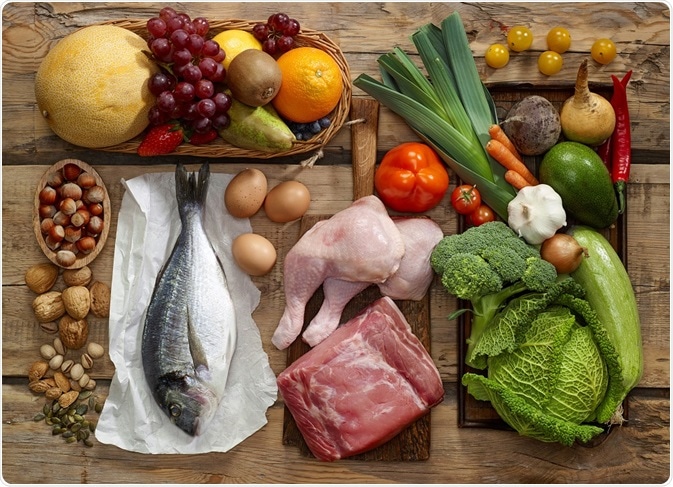Individuals who follow the paleo diet try to consume food similar to that of a caveman from 2.5 million to 10,000 years ago.
 Credit: MaraZe/Shutterstock.com
Credit: MaraZe/Shutterstock.com
It is thought that cavemen and hunter-gatherers had an extremely varied diet, not unlike the native diets of all indigenous cultures.
What a Paleo diet contains
A Paleo diet contains plenty of vegetables, fruits, nuts, and seeds, contributing about 35-45% of all caloric intake. Vegetables chosen are usually especially low in starch, such as carrots and leafy vegetables, which Paleolithic populations are supposed to have found abundantly in their environment.
Since these vegetables have a low glycemic index, they encourage low, steady levels of blood sugar rather than abrupt spikes. They also ensure the dietary fiber content is high.
The main constituent of a Paleo diet is protein from animal foods, especially lean meat from grass-fed bovinae, free-range poultry, and marine fish. Wild game is also acceptable. Fish rich in omega-3 fatty acids are preferred, such as albacore tuna, salmon, and mackerel.
Natural oil intake is high, derived from avocados, nuts such as walnuts or macadamia, seeds such as flaxseed, and coconut oil, along with the animal meat and fish. Plenty of water makes up the remainder of the diet.
What a Paleo diet does not contain
A strict Paleo diet will never have salt, refined sugar, processed foods, refined vegetable oils or potatoes. It will also notcontain any whole or refined grains in any form, nor any legumes or dairy products. Wheat, barley, spelt, oats, and rye are all excluded, as are beans, peas, garbanzo, peanuts, and lentils.
This is despite the fact that legumes are known to contain high-quality vegetable protein which complements the protein content of whole grains to produce a complete protein. Grains, on the other hand, provide not only a large amount of protein but also good amounts of fiber, vitamins, and other nutritional factors which are essential to a healthy diet.
These foods are generally staples or at least regular additions to the staple foods in most developing countries, because they cost much less to grow and harvest, and take up much less soil, as well as being more practical to distribute to consumers due to their low perishability.
Risks of a Paleo diet
Some Paleo diet plans are less rigid than others; it is recommended that a Paleo diet should not become a proxy for self-esteem by adhering to some imaginary line between ‘good’ and ‘bad’ foods. A certain flexibility is highly advised, not only to prevent burnout by making the diet more sustainable long-term, but also to avoid the psychological sequelae of feeling chronically deprived of one’s favorite foods.
Moreover, common sense dictates that plant-based diets which include legumes are unlikely to be unhealthy, whatever one’s health condition. The only food identified so far that can be harmful to the gut is gluten, and even this is not backed by unequivocal evidence.
A sample Paleo diet
Paleo diets largely feature lean cuts of meat, fish, poultry or pork, with a portion of fruit, leafy vegetables with carrots, cucumbers, or tomatoes, or other steamed vegetables such as broccoli or mixed greens. Snacks will be mostly vegetable sticks or fruit.
It is quite possible that the same health benefits could be achieved without quite so much sacrifice, provided the diet contained only enough whole grains to balance the energy expenditure, plant and animal protein in moderation, little animal fat and plenty of fresh vegetables with some fresh fruit and nuts every day, and is combined with enough exercise, plenty of water, and sufficient relaxation.
Conclusion
The transformative health benefits of a Paleo diet are widely debated, with the drawbacks of the diet often equalling the benefits. While the exclusion or limitation of some food groups can be beneficial, for example a reduced intake of sugar and sodium, deficiencies can arise from other adjustments in the diet, such as calcium deficincies. The diet’s similarity to that of Paleolithic populations is also contested.
Sources:
- www.mayoclinic.org/…/art-20111182
- www.ucdmc.ucdavis.edu/…/20150603_paleo-diet.html
- www.health.harvard.edu/…/the-paleo-diet-back-to-the-stone-age
- patient.info/…/paleolithic-diet-paleo-diet
- https://extension.psu.edu/paleo-diet-back-to-the-stone-age
Further Reading
- All Paleo Diet Content
- Paleo Diet: Pros and Cons
- Paleo Diet History
- Paleo Diet Evidence
Last Updated: Feb 27, 2019

Written by
Dr. Liji Thomas
Dr. Liji Thomas is an OB-GYN, who graduated from the Government Medical College, University of Calicut, Kerala, in 2001. Liji practiced as a full-time consultant in obstetrics/gynecology in a private hospital for a few years following her graduation. She has counseled hundreds of patients facing issues from pregnancy-related problems and infertility, and has been in charge of over 2,000 deliveries, striving always to achieve a normal delivery rather than operative.
Source: Read Full Article
